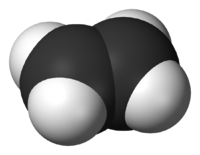
Photo from wikipedia
The intramolecular H-shift reactions of hydroperoxy-alkenyl-peroxy radicals are one of the key reaction classes in low-temperature combustion for alkenes. Depending on the types of carbons from which the hydrogen atoms… Click to show full abstract
The intramolecular H-shift reactions of hydroperoxy-alkenyl-peroxy radicals are one of the key reaction classes in low-temperature combustion for alkenes. Depending on the types of carbons from which the hydrogen atoms are transferred and ring size of the transition states, this reaction class is divided into different subclasses in this study. All geometry optimizations are performed at the M05-2X/6-311G(d,p) level. The conventional transition state theory with the CBS-QB3 method is used for the calculation of the rate constants at a high-pressure limit. The Rice–Ramsberger–Kassel–Marcus/master equation method is used for the calculation of the pressure-dependent rate constants at pressures varying from 0.01 to 100 atm. The individual rate constants for all reactions in the temperature range from 500 to 2000 K are given in the form of the modified Arrhenius expression. Rate rules for all subclasses are obtained by the average over the rate constants of representative reactions in each subclass. It is sho...
Journal Title: Energy & Fuels
Year Published: 2019
Link to full text (if available)
Share on Social Media: Sign Up to like & get
recommendations!